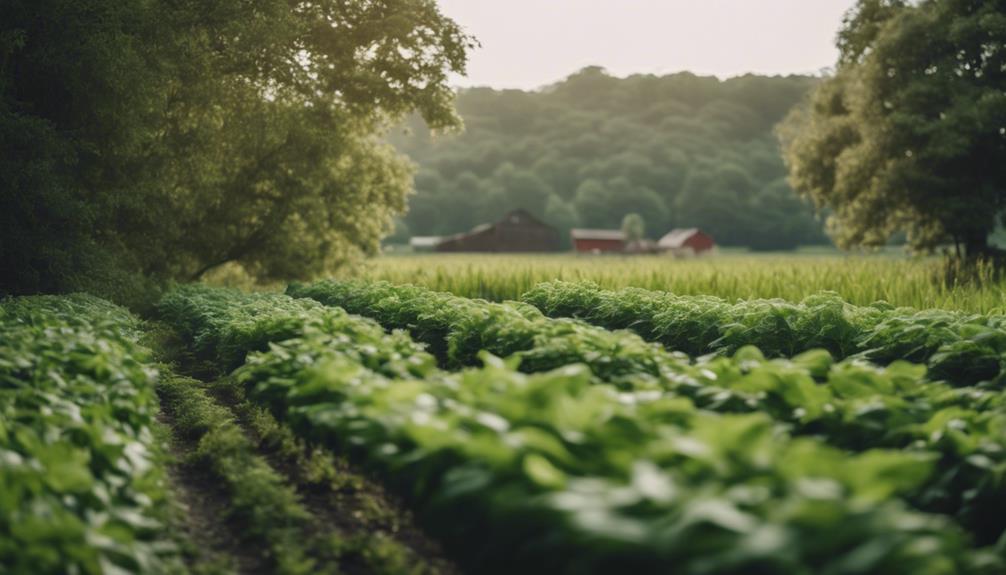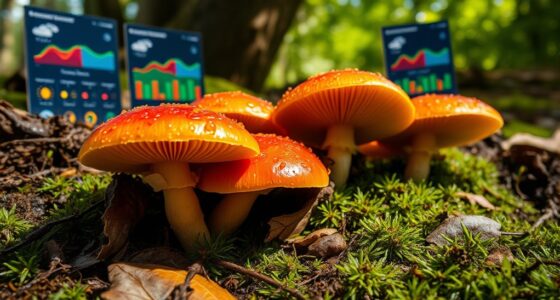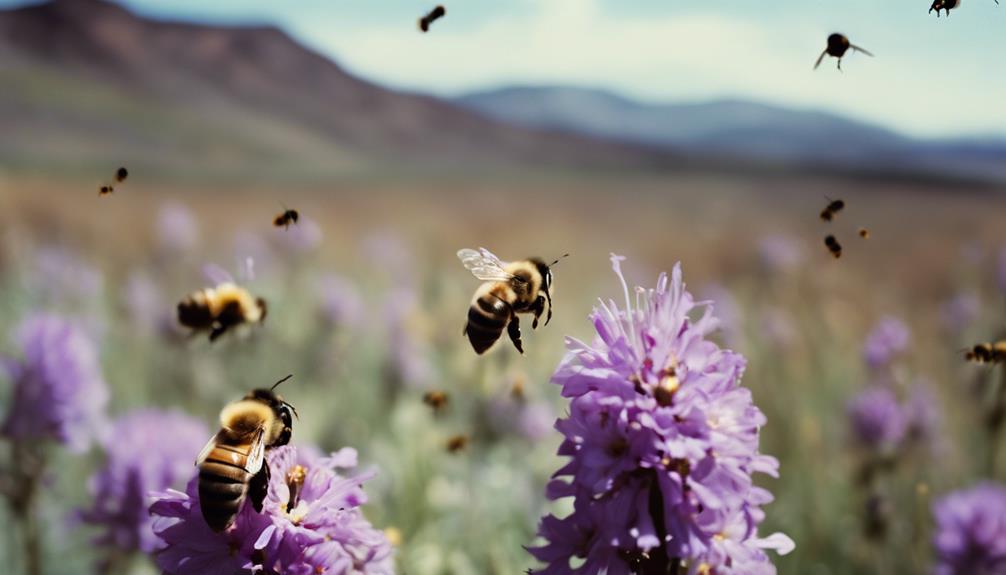Foraging and farming have their own benefits and drawbacks. Foraging promotes sustainability with minimal environmental impact, supporting biodiversity. However, farming excels in food production efficiency and supporting larger populations. Foraged foods are nutrient-rich, while farmed foods allow for surplus storage. Encouraging communal ties, foraging maintains traditional skills, while farming fosters stability. Balancing both practices enhances sustainability, biodiversity, and food production. The integration of foraging into modern farming techniques promotes ecosystem health. As you explore further, you'll discover how combining these practices can lead to a harmonious balance for a thriving future.
Key Takeaways
- Foraging promotes sustainability and minimal environmental impact.
- Farming surpasses foraging in food production efficiency and scalability.
- Foraged foods offer higher levels of essential nutrients and diverse plant compounds.
- Farming supports larger populations and provides a stable food supply.
- Balancing foraging and farming practices ensures long-term sustainability and resource availability.
Historical Perspectives on Foraging Vs Farming
Explore the historical perspectives on foraging versus farming to understand the complexities of human societies' choices and challenges.
When early human societies began to domesticate animals, they laid the foundations for a significant shift in how communities sourced their food. This shift marked a turning point where certain groups chose to settle down and cultivate crops, while others continued to rely on hunting and gathering.
The decision to domesticate animals wasn't made uniformly across all societies, with some opting to remain as foragers rather than embracing farming practices. Evidence indicates that for some communities, farming wasn't always a voluntary choice but a result of various factors such as environmental pressures or population growth.
These differing approaches to food production led to contrasting outcomes, with some farming societies experiencing societal inequalities and decreased health compared to foraging groups challenging assumptions about progress and values associated with agriculture.
Environmental Impact of Foraging

Foraging has a minimal environmental impact as it relies on natural resources without causing significant ecosystem alterations.
Hunter-gatherer societies practice sustainable foraging, maintaining a balanced relationship with their environment.
Foraging Vs. Land Use
With its lower environmental impact on land use compared to intensive agriculture, foraging emerges as a sustainable practice that promotes biodiversity and ecosystem resilience.
Hunter-gatherer societies often implement sustainable land management techniques to guarantee the preservation of resources. By foraging for food, minimal disturbance occurs in natural habitats, supporting ecosystem resilience and species diversity. This minimal disruption allows ecosystems to thrive without extensive modifications, contributing to the conservation of wildlife and the preservation of landscapes.
Sustainable foraging practices play a crucial role in maintaining the delicate balance of our environment. Compared to intensive farming, foraging offers a more harmonious approach to land use, benefiting not only the local flora and fauna but also ensuring the long-term sustainability of our natural resources.
Embracing the principles of sustainable land management through foraging can lead to healthier ecosystems and a more balanced coexistence with nature.
Biodiversity and Foraging
Promoting biodiversity through foraging involves allowing natural ecosystems to thrive without the intense human interference often associated with agriculture. By foraging for food, you contribute to the preservation of diverse habitats and the overall resilience of ecosystems.
Here are three key ways foraging supports biodiversity:
- Hunter-Gatherer Societies: Relying on diverse food sources gathered from the environment, these societies play an essential role in maintaining ecosystem health.
- Balanced Relationship: Foraging sustains a harmonious coexistence between humans and nature, helping preserve a variety of plant and animal species.
- Sustainable Practices: Foraging techniques prioritize responsible resource consumption, reducing the risks of overexploitation and environmental degradation.
Through these practices, foraging not only provides sustenance but also plays an important role in preserving the natural world around us. By foraging responsibly, you can help protect and promote biodiversity for future generations.
Efficiency in Food Production: Farming Vs Foraging

Achieving higher food production efficiency, farming surpasses foraging in supporting larger populations per hectare. Agriculture's ability to produce food in a more concentrated and efficient manner allows for the sustenance of greater numbers of people compared to the more sporadic nature of foraging.
With farming, the surplus food produced can be stored for future consumption, providing a significant advantage during times of scarcity that foragers don't have. This surplus also enables agricultural societies to support populations during periods when food sources are scarce or unpredictable.
Additionally, the efficiency of farming contributes to the long-term survival prospects of societies by providing a stable and consistent food supply, which is crucial for sustained growth and development. In contrast, foraging, while sustainable for smaller groups, lacks the scalability and predictability that farming offers, making it less efficient in supporting larger populations over time.
Nutritional Value Comparison: Foraged Vs Farmed Foods

Comparing the nutritional value of foraged foods to farmed foods reveals significant differences in essential nutrients and health benefits. When it comes to nutrient density, foraged foods often come out on top. Here are some key points to keep in mind:
- Higher Levels of Essential Nutrients: Foraged foods typically contain increased amounts of vitamins, minerals, and antioxidants compared to their farmed counterparts.
- Diverse Plant Compounds: Wild foraged foods are known to harbor a variety of beneficial plant compounds that can support overall health and well-being.
- Bioavailability: Nutrition studies suggest that foraged foods have higher nutrient density and bioavailability, meaning the body can absorb and utilize these nutrients more effectively.
Incorporating a variety of foraged foods into your diet can provide you with a wider range of essential nutrients for improved health. So, next time you're out foraging or shopping for produce, keep in mind the nutrient-packed benefits of foraged foods.
Sustainability: Foraging and Farming Practices

When considering sustainability in food production, the contrast between foraging and farming practices becomes evident in their environmental impacts. Foraging, by its nature of gathering food without altering the environment, tends to have a lower impact, supporting biodiversity conservation and maintaining ecosystems. This method aligns well with the environment's carrying capacity, ensuring resources are utilized sustainably.
On the other hand, farming involves manipulating the land for agriculture, which can lead to deforestation, soil degradation, and water pollution, potentially exceeding the ecosystem's carrying capacity. Finding a balance between foraging's minimal ecological footprint and farming's higher food production capacity is essential for creating sustainable food systems that meet the needs of the present without compromising the ability of future generations to meet their own needs.
Cultural and Social Significance of Foraging

Foraging holds a deep historical significance, tracing back to our ancestors who relied on the land for sustenance.
Community foraging traditions have been passed down through generations, fostering a sense of shared knowledge and connection to the environment.
Exploring the roots of foraging practices sheds light on the cultural tapestry woven by these sustainable lifestyles.
Foraging in History
The cultural and social significance of foraging in history is deeply rooted in the sustainable practices and communal bonds fostered by early human societies' reliance on hunting, fishing, and gathering wild plants. Foragers lived in small, mobile groups, drawing on their immediate surroundings for sustenance. This lifestyle led to a diverse diet, rich in nutrients and connected to the natural world.
Three key aspects highlight the importance of foraging in history:
- Intricate Environmental Knowledge: Foraging cultures possessed detailed knowledge of their environments, including plants and animals, which was passed down through generations.
- Communal Bonds: The practice of foraging encouraged strong communal ties, fostering egalitarian social structures and cooperation among group members.
- Ecological Understanding: Foragers developed a deep understanding of ecological relationships, recognizing the interconnectedness of all living beings in their ecosystems.
Community Foraging Traditions
Community foraging traditions reflect a deep-rooted connection to cultural practices and social bonds, highlighting the importance of shared knowledge and cooperation among group members.
Within a community, foraging serves as more than just a means of obtaining food; it strengthens relationships and fosters a sense of unity among individuals. Foragers rely on the wisdom and expertise passed down through generations, preserving traditional skills and techniques that contribute to sustainable practices and a harmonious relationship with nature.
The act of foraging not only sustains the community physically but also spiritually, often intertwining with ceremonial rituals that hold deep cultural significance. Through community foraging, people come together to celebrate their heritage, strengthen social ties, and honor the land that provides for them.
This shared experience of gathering food from the natural environment creates a sense of belonging and interconnectedness, enriching the cultural tapestry of the community.
Challenges of Foraging and Farming

Managing the uncertainties of food availability presents a significant challenge for both foraging and farming societies. While foragers rely on immediate resources for sustenance, farmers face the consistent labor of crop cultivation.
Here are three specific challenges faced by foraging and farming communities:
- Food Storage: Foraging communities often struggle with the perishable nature of their food sources, needing to consume or preserve what they gather promptly.
- Resource Allocation: Farmers must carefully manage land resources to guarantee sustained food production, impacting settlement patterns and community development.
- Social Structures: Foragers tend to have more flexible social structures due to their mobility, while farmers develop complex hierarchies within settled communities.
These challenges influence survival strategies and societal structures, shaping the way both foraging and farming communities interact with their environments. Balancing the uncertainties of food availability with resource management remains a key consideration for both lifestyles.
Future Outlook: Balancing Foraging and Farming

To promote sustainable food production and environmental preservation, finding a balance between foraging and farming practices is essential. As we look towards the future, integrating elements of foraging into traditional farming methods can have significant benefits for both food security and ecosystem health.
By combining the knowledge of foraging with modern agricultural techniques, we can enhance biodiversity, increase resilience, and promote long-term sustainability.
Incorporating foraging practices into farming can also help in mitigating the environmental impact of agriculture. Sustainable agriculture models aim to minimize harm to ecosystems while maximizing food production for future generations. This approach not only guarantees the availability of resources for years to come but also contributes to the overall health of our planet.
Finding this harmonious balance between foraging and farming is important for maintaining life expectancy, both for human populations and the diverse species that rely on healthy ecosystems for survival. By working towards a more integrated approach to food production, we can move towards a future where both humans and nature thrive together.
Frequently Asked Questions
Is Foraging Better Than Farming?
When weighing the benefits, consider the historical health indicators favoring foraging societies. Longer life expectancy, improved dental health, and a diverse diet are notable advantages. Foragers' mobility aids in adapting to environmental changes and promotes sustainability.
Why Were Foragers Healthier Than Farmers?
Foragers were healthier than farmers due to their varied diet, active lifestyle, and lower exposure to diseases from domesticated animals. Their diet rich in diverse foods contributed to better health indicators and overall well-being.
What Are the Advantages and Disadvantages of Hunting and Foraging Versus Agriculture?
When considering the advantages and disadvantages of hunting and foraging versus agriculture, remember that foraging offers variety and less labor, while agriculture provides surplus and supports larger populations. Both methods have their strengths and weaknesses.
Is Foraging Good or Bad?
Is foraging good or bad? Both have merits. Foraging offers varied diets, leisure, and sustainability. Yet, farming provides stability, productivity, and food security. Consider your needs and values to decide what suits you best. Ultimately, the choice between foraging and farming often depends on personal preference, lifestyle, and environmental factors. While some might enjoy the freedom and connection with nature that foraging offers, others may prioritize the reliability that farming ensures. Weighing the foraging minions pros and cons can help highlight the differences, enabling you to make an informed decision that aligns with your goals. Ultimately, both approaches have their place depending on what you value most—whether it’s sustainability or consistency. Understanding the **foraging minions pros and cons** allows individuals to differentiate between the freedom of foraging and the stability of farming. By evaluating these factors, one can make a decision that not only meets their personal or community goals but also respects the environment they inhabit.
Conclusion
To guarantee a sustainable future, both foraging and farming have their own benefits and drawbacks. While foraging offers a connection to nature and diverse nutritional options, farming provides efficiency and stability in food production.
Finding a balance between the two is crucial for a sustainable future. As the saying goes, 'Don't put all your eggs in one basket.' It's important to take into account the environmental impact, nutritional value, and cultural significance of both methods to ensure a thriving food system for generations to come.










